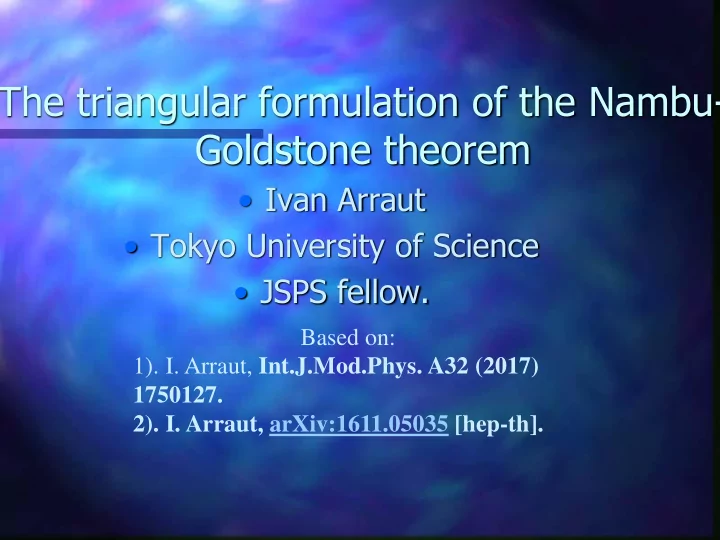

The triangular formulation of the Nambu- Goldstone theorem • Ivan Arraut • Tokyo University of Science • JSPS fellow. Based on: 1). I. Arraut, Int.J.Mod.Phys. A32 (2017) 1750127. 2). I. Arraut, arXiv:1611.05035 [hep-th].
Content • 1). Motivation. • 2). How to construct the commutators graphically. SSB. • 3). The Nambu-Goldstone theorem as a triangular relation (QYBE). • 4). The dispersion relations for the N. G bosons. • 5). The counting of N. G. bosons based on the matrices satisfying the QYBEs. (Automatic).
Motivation • 1). Creating a consistent framework (scenario) by starting from fundamental dynamics in order to explain why the Nambu-Goldstone bosons have some unusual way to disperse in some circumstances. • 2). Developing a consistent framework for spacetime symmetries.
History of the problem.
Standard Nambu-Goldstone theorem Given a system obeying some symmetries, the number of broken generators is equal to the number of Nambu- Goldstone bosons. The dimension of the coset space determines the number of Goldstone bosons.
The triangle formulation For a group of symmetries obeying the Lie Algebra, then the spontaneous symmetry breaking condition, can be expressed as This expression can be expanded in four different terms, each one corresponding to a triangle. It comes out that the triangle relations govern the dynamics of the Goldstone bosons.
Triangle relations
Commutation relations
Everything is obtained from the fundamental lines.
The multiplicity of vacuums, can be understood in the following way We are summing over all the possible degenerate vacuums. But what is the sense of summing over all the degenerate vacuums? A: Only in this way we can apply the Quantum Yang-Baxter equations to this problem.
The triangle relations If we expand the double commutator found previously, then we get They are obtained after expanding the previous double commutator. Note that here we have omitted the phases. The phases will appear after including the spacetime translational invariance condition:
Note that we have introduced two sets of complete intermediate states . Note that the double commutator previously mentioned can be expanded up to some phases as: How can we factorize these terms? A: Quantum Yang Baxter equations QYBE The matrices are bilinear objects acting on the space
The Matrices are defined by: The red indices are auxiliary indices. Then we have promoted the charges and the order parameter as a second order rank tensor.
Coordinate notation for the matrices. In the relation under study, the internal lines in the QYBE will correspond to the degenerate vacuum plus the pair of complete set of intermediate states. The complete sets correspond to the pair of Goldstone bosons. The coordinate form for the QYBE is In our case, we will be concerned with the equivalent relations
Here we have introduced the notation The previous condition is equivalent to
Note that the previous relations are worked in two different notations. What happens if we exchange the particles locations as follows? The two triangle relations previously exposed demonstrate that we can factorize two pair of terms from the double commutator.
In our convention, the slopes are related to the spatial momentum of the particles. If the condition is satisfied, then it is possible to understand that the exchange , is equivalent to the following exchange of phases: Here we are also assuming interaction of identical particles such that .
Case 1: Both degrees of freedom equivalent. In this case the two QYBE are equivalent and we can factorize all the terms.
We finally get the following result In the following limits We get
Case 2). The pairs of particles independent. Broken generators independent. In this case we cannot factorize the previous expressions further and then the dispersion relation will be linear.
Chemical potential case
In this case, the symmetry is also explicitly broken and the Goldstone bosons can in addition obtain some mass. The only new ingredient, necessary in order to get the dispersion relations is the relation Then the previous equations become
The meaning of the auxiliary indices???:D-branes labels?? This is the schematic representation of three coincident D-branes . They have to be coincident if we want to avoid dynamical origins of masses. 9 Sectors. Which sectors are the relevant ones? Each matrix R represents sectors interactions between pairs of D-branes (6 sectors in total). Calculations in process.
Conclusions • 1). The dynamic of pairs of Goldstone bosons is governed by the QYBE’s • 2). Under some circumstances, pairs of Goldstone bosons with linear dispersion relations, become effectively a single degree of freedom with quadratic dispersion relation. • 3). When there is a chemical potential, the Goldstone bosons can get a mass, defined by the symmetry group and by the chemical potential.
Recommend
More recommend